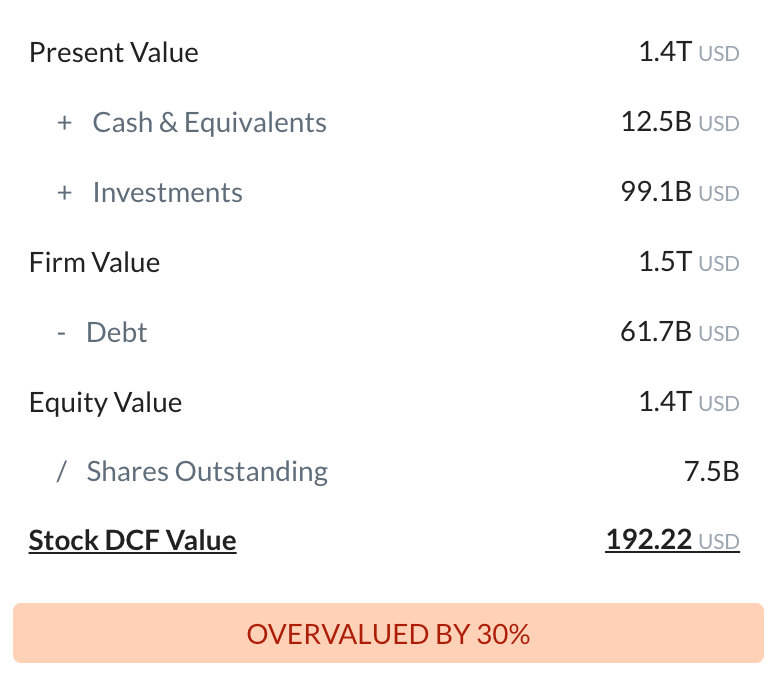
Apple Inc
NASDAQ:AAPL

Intrinsic Value
The intrinsic value of one
 AAPL
stock under the Base Case scenario is
152.07
USD.
Compared to the current market price of 191.965 USD,
Apple Inc
is
Overvalued by 21%.
AAPL
stock under the Base Case scenario is
152.07
USD.
Compared to the current market price of 191.965 USD,
Apple Inc
is
Overvalued by 21%.
The Intrinsic Value is calculated as the average of DCF and Relative values:

Valuation History
Apple Inc

Fundamental Analysis

The company’s heavy reliance on iPhone sales leaves its overall revenue vulnerable if the smartphone market slows or consumers shift toward more cost-effective alternatives.
Apple’s robust ecosystem, anchored by iPhone, Mac, and iPad, cultivates strong customer loyalty and recurring hardware upgrade cycles that drive revenue stability.

Revenue & Expenses Breakdown
Apple Inc

Balance Sheet Decomposition
Apple Inc

| Current Assets | 153B |
| Cash & Short-Term Investments | 65.2B |
| Receivables | 66.2B |
| Other Current Assets | 21.6B |
| Non-Current Assets | 212B |
| Long-Term Investments | 91.5B |
| PP&E | 45.7B |
| Other Non-Current Assets | 74.8B |
Free Cash Flow Analysis
Apple Inc

| USD | |
| Free Cash Flow | USD |
Earnings Waterfall
Apple Inc

|
Revenue
|
395.8B
USD
|
|
Cost of Revenue
|
-211.7B
USD
|
|
Gross Profit
|
184.1B
USD
|
|
Operating Expenses
|
-58.4B
USD
|
|
Operating Income
|
125.7B
USD
|
|
Other Expenses
|
-29.5B
USD
|
|
Net Income
|
96.2B
USD
|
AAPL Profitability Score
Profitability Due Diligence

Apple Inc's profitability score is 80/100. The higher the profitability score, the more profitable the company is.

Score
Apple Inc's profitability score is 80/100. The higher the profitability score, the more profitable the company is.
AAPL Solvency Score
Solvency Due Diligence

Apple Inc's solvency score is 58/100. The higher the solvency score, the more solvent the company is.

Score
Apple Inc's solvency score is 58/100. The higher the solvency score, the more solvent the company is.
Wall St
Price Targets
AAPL Price Targets Summary
Apple Inc

According to Wall Street analysts, the average 1-year price target for
 AAPL
is 256.141 USD
with a low forecast of 185.699 USD and a high forecast of 341.25 USD.
AAPL
is 256.141 USD
with a low forecast of 185.699 USD and a high forecast of 341.25 USD.
Dividends
Current shareholder yield for  AAPL is
.
AAPL is
.
Shareholder yield represents the total return a company provides to its shareholders, calculated as the sum of dividend yield, buyback yield, and debt paydown yield. What is shareholder yield?
The intrinsic value of one
 AAPL
stock under the Base Case scenario is
152.07
USD.
AAPL
stock under the Base Case scenario is
152.07
USD.
Compared to the current market price of 191.965 USD,
 Apple Inc
is
Overvalued by 21%.
Apple Inc
is
Overvalued by 21%.
























































 You don't have any saved screeners yet
You don't have any saved screeners yet